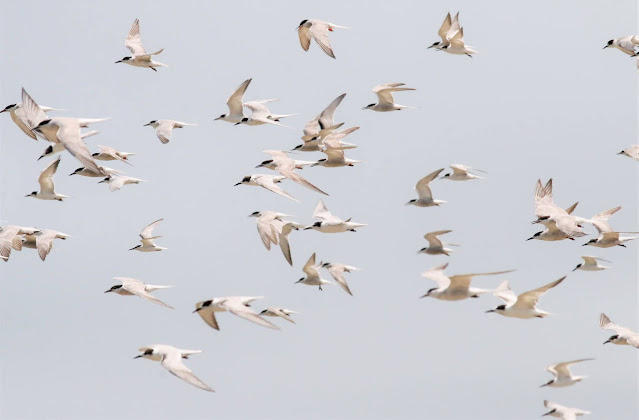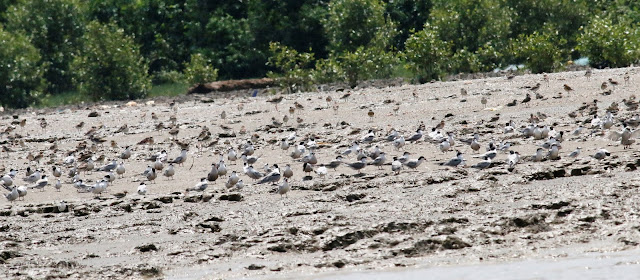I have always wanted to see for myself those waders which stayed behind through out their summer season here. The month of June would be the perfect time and I have a rare opportunity to do so due to the partial lifting of cross-borders restrictions. This time my birding adventures took me deeper into the mudflats of Kota Kuala Muda. The timing wasn't perfect as it was at 15.00hrs (3.00pm) but that was the only time I have. Here are some of the waders' photos taken under the scorching sun.
The entire synopsis of this trip and post can be described from the above photo. There were lots of Red-necked Stint (Calidris ruficollis), several Common Redshank (Tringa totanus) and a few Curlew Sandpiper (Calidris ferruginea). Also seen but not shown here were several Lesser Sand Plovers (Charadrius atrifons).
Lets start with the Red-necked Stint (RNS)
A typical profile of a RNS
Most of them are still in their first or perhaps second winter plumage
This one shows a bit of its first summer plumage (30% perhaps?)
RNS taking off
RNS in flight
(note: its white tail-sides demarcated by a dark median stripe are similar to those of a Temminck's Stint but the latter are more commonly found inland than on a mudflat)
Next are the Common Redshank
Most of them stayed near the shoreline or where there are small pools of water. So at times I have to wade into the soft mud to get closer to them.
Some of them did approached quite close like this one.
Dave Bakewell, our endowed resident birding advisor reckoned that the above wader is an European subspecies ! Currently there are probably five (5) subspecies which have been positively identified by researchers.
It is already showing its stunning breeding plumage
The questions is "will it depart to its breeding grounds like its earlier relatives"? or "will it stay behind to breed here"?
Some are partially into their first summer plumage like this one.
oops ! I have finally been spotted.
This one looks a bit different
A pair of twins perhaps?
Wading under the blistering heat
To take their photos, you will need to remain motionless - like a dead tree trunk ! For the above photo, I have used the cover of a small bush but they were still wary of my presence. A sudden twitch of the body or arm, its bye bye !
Curlew Sandpipers
This is an interesting wader which is now considered as 'Near-threatened'. They usually breed in the tundra in Russia. Again, will it be too late for them to fly back ?
Like the earlier Common Redshank, this Curlew Sandpiper is also into its first summer plumage.
Only 5 of them were sighted this time.
Two of them were in their 1st/2nd winter plumage like the above wader. Maybe this one will remain here during summer.
A Common Redshank and a Curlew Sandpiper side-by-side for comparison
Lesser Sandplover
Its upper-wing plumage will certainly blend well with the colors of the mudflats.
Most of the Lesser Sandplovers sighted were in their semi-winter plumage.
Compared with the RNS on the right, this Lesser Sandplover is still a long way to breeding plumage.
This one is slightly at a more advance summer stage
Look how deep their feet sinks into the mud.
Once they are in their full summer plumage, their colors are more vivid.
Only a few of them are in their almost complete summer plumage, like these ones.
Could one of them be a Mongolus subspecies?
Here is a series of photos depicting how a Charadrius (in this case a Lesser Sandplover) extract a marine worm from the mud.
According to Dr Nur Munira, the lead researcher and recipient of an internationally funded shorebirds survey project here, "Charadrius use stop and hunt technique while Calidris search the mudflats with rapid pecking at the surface".
Note: the marine worm is most likely belongs to a species called polychaetes (also known as bristle worms)
I huff and I puff !
One mighty bird versus one die-hard worm.
(At the end the wader manages to get only half of its meal)
There are plenty of food in the mudflats for these waders.
Lastly, here is a wader which you would least expect on a mudflat
Most of the time you would find it on dry grasslands or open countries (inlands). Over here it is leading a flock of Little Terns (Sterna albifrons) after they were flushed out by a Little Egret (not in the photo).
Now it is ahead of the flock.
Yup ! its an Oriental Pratincole (Glareola maldivarum)
It flew just right above before moving further away.
"Humans have been explorers forever"
(Ed Stone, NASA Voyager Project Scientist)
..... and i am just one of them.






























































